
* The S-70 Black Hawk was a significant step forward in utility helicopter capability for the US Army when it was developed in the mid-1970s. Since that time, it has also proven useful for other roles, such as search and rescue, special operations, medical evacuation, and electronics warfare; and has been acquired by military services around the world.
* The Bell UH-1 Huey series of helicopters served the US Army very well in Vietnam, but even as the conflict was heating up in the mid-1960s, the Army was beginning to think about a replacement. As the war wound down late in the decade, the search for a replacement helicopter came to the top of the queue, and the Army issued a request for industry proposals for the "Utility Tactical Transport Aircraft System (UTTAS)" in January 1972, specifying new levels of performance, survivability, and maintainability.
Boeing Vertol and Sikorsky proposals were selected as finalists in August 1972, with each manufacturer building two ground-test prototypes and three flight-test prototypes, to be put through an extensive evaluation before selection of a winner. Sikorsky preceded prototype construction with a set of five demonstrators, based on modified S-61 and S-65 transport helicopters plus the experimental S-67 gunship, to validate UTTAS technologies.
The first flying Sikorsky UTTAS prototype, with the company designation of "S-70" (later "S-70A") and the service designation of "YUH-60A", performed its initial flight on 17 October 1974. The Boeing Vertol entry, the "YUH-61A", performed its first flight on 29 November 1974. The Army evaluation of the machines began in the spring of 1976 and was very thorough.
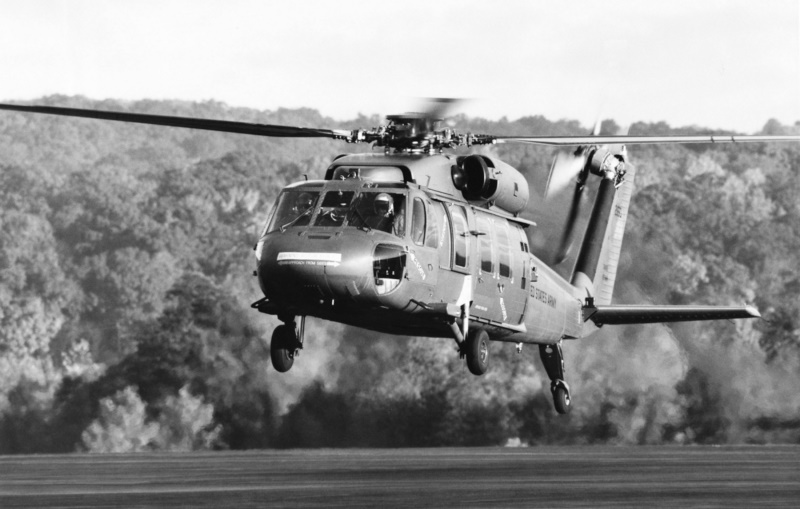
The Army was particularly impressed when one of the Sikorsky YUH-60A prototypes crash-landed in a heavily wooded area at Fort Campbell, Kentucky. The aircrew was unharmed, and after replacing the rotor blades the helicopter flew itself out, to be full service with minimal additional repairs. Sikorsky was judged the winner of the competition on 23 December 1976, with the company awarded an initial production contract for the "UH-60A Black Hawk". The contract specified delivery of three more YUH-60As and 15 initial-production UH-60As. Many more production orders would follow.
Initial flight of a production Black Hawk was on 17 October 1978, four years to the day after the initial prototype flight, and the type entered service with the US Army's 101st Airborne Division in June 1979. Although the Black Hawk's reliability wasn't up to spec initially, the problems were largely overcome. The UH-60A saw initial combat service in the US invasion of the island of Grenada in 1983. One demonstrated its survivability by coming home with a wounded pilot, 45 bullet holes in the airframe, two holes in the main rotor, and one in the tail rotor; in one incident, a flight of Black Hawks survived antiaircraft fire that would have wiped out a comparable flight of Hueys. UH-60As would also see service in the invasion of Panama, Operation JUST CAUSE, in 1989.
BACK_TO_TOP* The UH-60A was of conventional main-tail rotor configuration and was powered by twin General Electric T700-GE-700 turboshaft engines, providing 1,165 kW (1,560 SHP) each. The engines were rated to operate for a half hour, even following complete loss of oil. A Solar T62T-40-1 auxiliary power unit (APU) with 75 kW (100 SHP) is mounted between the engines for starting and ground power. The UH-60A had wheeled, fixed tailwheel landing gear featuring heavy-duty shock absorbers to take up the shock of a hard landing. The landing gear could be fitted with additional wide ski-style pads for operations on snow or marshy ground. The fuel tanks were also crash-resistant, and armored as well.
Both the main and tail rotors had four blades. They could resist impacts of 23-millimeter cannon projectiles. Each main rotor blade had titanium spars, glass-fiber skinning, a honeycomb core, and a nickel leading-edge abrasion sheath. The tail rotor was made of graphite-epoxy composite and was canted at an angle of 20 degrees off the vertical. There was a straight tailplane, or "stabilator", at the base of the tailfin. The main rotor could be manually folded for air transport. As per UTTAS requirements, a Lockheed C-130 transport could carry one Black Hawk, and a Lockheed C-5 could carry six. The more modern C-17 could carry two.
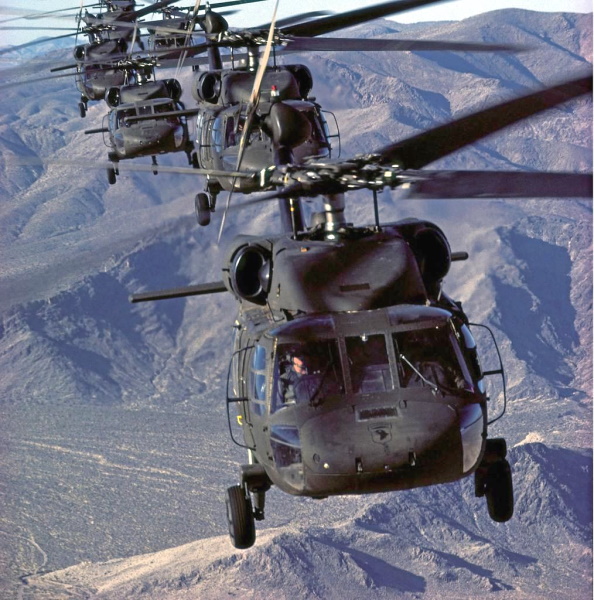
The UH-60A had a crew of three, including two pilots and a crew chief / gunner, all sitting on armored seats. 11 troops were carried normally, though up to 20 could be accommodated in a pinch. There were doors on either side that slid rearwards and had two windows. The UH-60A had a belly sling hook with a lift capacity of up to 4,080 kilograms (9,000 pounds); it could lift a 105-millimeter artillery piece or a Hummer vehicle.
A machine gun could be pintle-mounted in a slide-open window on each side of the helicopter just behind the cockpit. Positioning the guns in the windows helped reduce clutter in the doorways, reflecting combat experience with the Bell UH-1H, when door guns interfered with troops trying to get out of the machine as fast as possible under fire. Initially, M60D 7.62-millimeter (0.30-caliber) machine guns were mounted, but later were replaced by General Electric M134 7.62-millimeter six-barreled Gatling Miniguns.
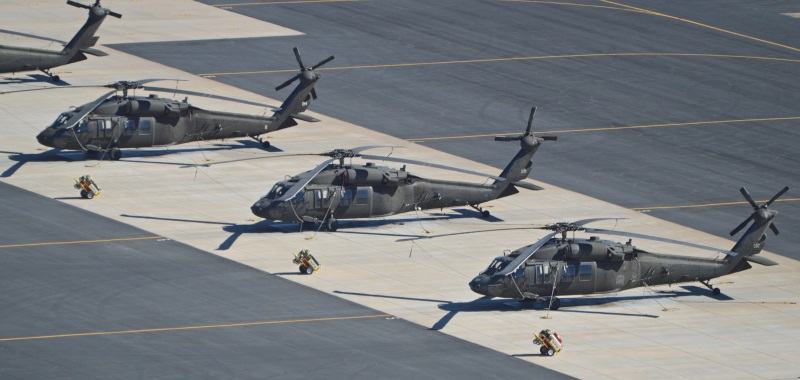
The initial prototype differed from production machines in having:
One visible difference was in window arrangement. The original window scheme included a two-panel side-cockpit window that proved drafty and was replaced by a window with a small slide-open panel, and the original one-piece windows behind the cockpit were replaced with two-piece windows that could be more easily opened. Of course, the prototype was not fitted with full operational kit. Changes were made through the development program that brought successive prototypes by steps to production specification.
___________________________________________________________________
SIKORSKY S-70 / UH-60A BLACK HAWK
___________________________________________________________________
main rotor diameter:
16.36 meters (53 feet 8 inches)
tail rotor diameter:
3.35 meters (11 feet)
footprint length:
19.76 meters (64 feet 10 inches)
fuselage length:
15.26 meters (50 feet 1 inch)
height, rotor head:
3.76 meters (12 feet 4 inches)
height, tail rotor:
5.13 meters (16 feet 10 inches)
empty weight:
4,820 kilograms (10,625 pounds)
MTO weight:
9,185 kilograms (20,250 pounds)
max speed:
295 KPH (185 MPH / 160 KT)
service ceiling:
5,790 meters (19,000 feet)
range, internal fuel:
592 KM (368 MI / 319 NMI)
___________________________________________________________________
Along with export sales of UH-60A variants, two UH-60As were obtained by the US Navy Test Pilot's School at Patuxent River, Maryland, and 14 UH-60As were passed on to the US Customs Service for drug enforcement duties. These machines were basically stock UH-60As, though they were fitted with a Nitesun searchlight, and were nicknamed "Pot Hawks". They were painted black with dark gold trim.
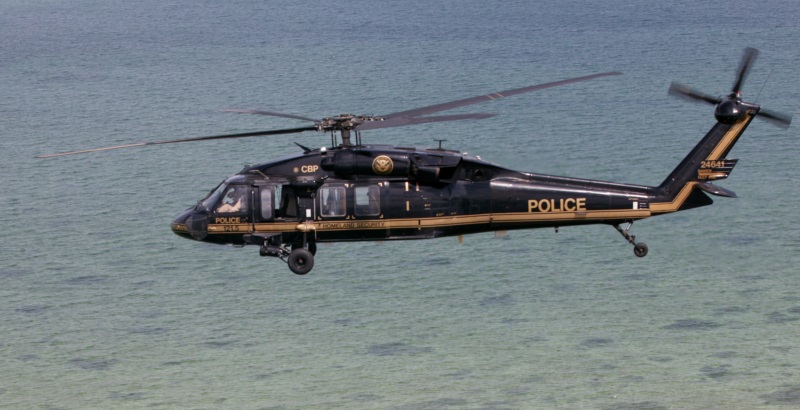
UH-60As set aside as ground instruction airframes are designated "GUH-60A", and a handful of machines reserved for experimental roles were designated "JUH-60A". One JUH-60A evaluated a "fly-by-light" fiber-optic-based flight-control system under the "Advanced Digital-Optical Control System (ADOCS)" program, and was of course nicknamed the "Light Hawk".
In 2012, one JUH-60A was flown unpiloted, with an autonomous flight control system, as a step towards the "optionally piloted" helicopter fleet of the future. This led to initial flights of an optionally piloted Black Hawk in 2014, the scheme being oriented towards providing resupply of remote outposts. A more advanced optionally-piloted UH-60A first flew in 2019 under the "Aircrew Labor In-cockpit Automation System (ALIAS)" -- a collaboration between Sikorsky and the US Defense Advanced Research Projects Agency (DARPA). The armed services have expressed interest in porting ALIAS technology to other rotorcraft.
* A number of improvements were added to the Black Hawk from its introduction:
* A total of 976 UH-60As was delivered to 1989 -- not counting six development machines and 66 conversions to the "EH-60A" configuration, described below -- when that variant was replaced in production by the improved "UH-60L". The UH-60L had more powerful T700-GE-701C turboshafts, providing 1,417 kW (1,900 SHP) each, and an uprated power transmission capable of handling a total of 2,535 kW (3,400 SHP).
All improvements added to the UH-60A during production became standard items on the UH-60L, which also featured a modified tail rotor control system. Early production UH-60Ls retained the UH-60A flight control system which limited available power, but this was quickly upgraded to the "Automatic Flight Control System (AFCS)" of the navalized S-70B Seahawk, which permitted full use of the new engines and powertrain. The Seahawk is discussed in the next chapter.
Initial flight of the UH-60L was on 22 March 1988, with service deliveries beginning in October 1989. By the beginning of 2002, the US Army had 539 UH-60Ls in service. A UH-60L looked much like a UH-60A, since many UH-60As were upgraded with features fitted standard to UH-60Ls, such as cable cutters and defensive countermeasures. In fact, it was the increasing weight penalty imposed by these features that drove the development of the UH-60L.
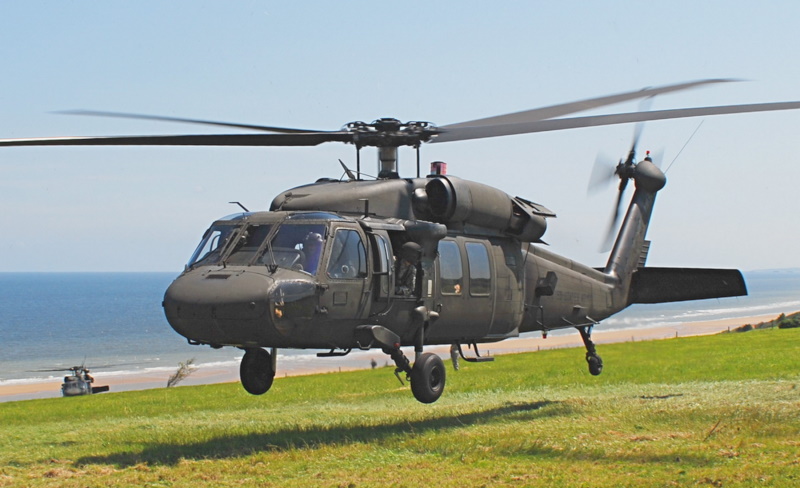
UH-60Ls were available to fly alongside UH-60As during the Gulf War in 1991, with the Army deploying about 400 Black Hawks of various types to support the conflict. They were fitted with protective covers and other items to protect them from desert sand, and priority was given to implementing upgrades such as long-range fuel tanks and improved avionics. On 24 February 1991, the first day of the ground war, Black Hawks were the primary element of the biggest single helicopter airlift in history to that time, with a total of over 300 machines participating in an assault on a site in the Iraqi desert codenamed "Landing Zone (LZ) Cobra". Six Black Hawks were lost during the conflict, two of them due to combat action, the other four due to accidents.
Black Hawks have of course participated in other US Army interventions since them, including the infamous Somalia intervention. On 3 October 1993, two Black Hawks were shot down during a botched raid, with the crew of one slaughtered and dragged through the streets -- the ugly incident becoming the basis for a well-known movie titled BLACK HAWK DOWN. Black Hawks served, with considerably more distinction, in the US intervention in Afghanistan from 2001 and the occupation of Iraq from 2003. Six UH-60Ls, upgraded from UH-60As, were obtained from Army stocks by US Customs.
BACK_TO_TOP* The Army wanted to obtain a specialized medevac version of the UH-60A, the "UH-60Q", to replace UH-60A/L machines configured for the medevac role. Like the UH-60A/L medevac machines, the UH-60Q had accommodations for litters and medical attendants, but the arrangements were much more optimal and a more extensive suite of emergency medical gear could be accommodated. The UH-60Q also featured a "forward looking infrared (FLIR)" video camera in the nose for night / bad weather flying, plus an external rescue hoist -- the UH-60A/L medevac machines had the old swing-out hoist, which apparently had a substantially smaller lift capacity.
Five "YUH-60A(Q)" evaluation conversions were performed in the 1990s to validate the configuration. It is unclear how many conversions were performed to the UH-60Q configuration. The UH-50Q led to an improved medevac conversion, the "HH-60L". Again, it isn't clear how many conversions were performed -- though 30 were eventually transferred elsewhere, including 10 to US Customs.
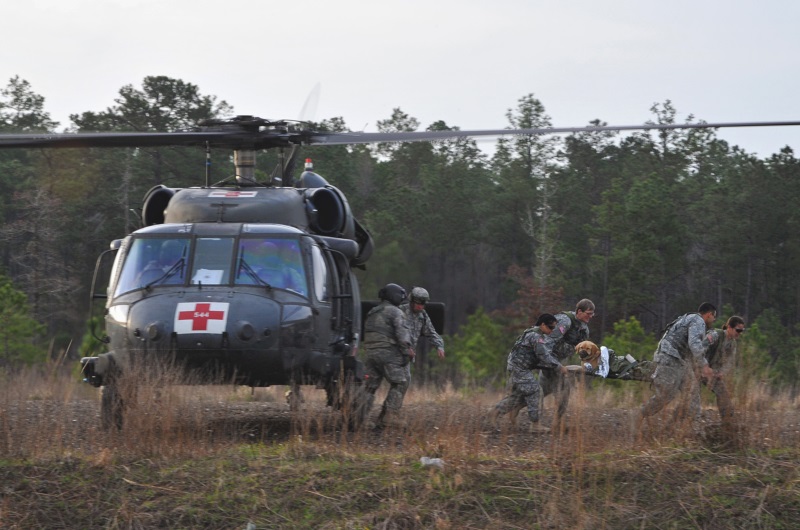
The Army also decided to convert 30 UH-60As to a special operations version, known as the "MH-60A", which featured:
Since many of its features were tacked on in an improvised fashion, the UH-60A was nicknamed the "Velcro Hawk". These machines were passed on to the Army National Guard in 1990 and returned to utility configuration, to be replaced in regular Army service by UH-60Ls brought up to a similar "MH-60L Velcro Hawk" configuration. Some UH-60Ls were fitted with external stores on ETS or ESSS stub wings, including a 30-millimeter Chain Gun and unguided rocket pods, and referred to by the name of "MH-60L Defensive Armed Penetrator (DAP)".
* The MH-60As and MH-60Ls were only interim machines, filling the gap until a much more optimized special operations "MH-60K" Black Hawk could be obtained. The MH-60K was basically a superset of the MH-60L Velcro Hawk, with such features as the inflight refueling probe, HIRSS exhaust shields, disco light IR jammer, chaff-flare dispensers, and NVG-compatible cockpit. It added a number of significant improvements:
A pintle mount for a 12.7-millimeter (0.50 caliber) machine gun was mounted in each door. It is unclear if the window Minigun mounts were retained. The 12.7-millimeter machine guns had a much lower rate of fire than the Miniguns, but more range and hitting power. The MH-60K was qualified for improved armament, including Stinger air-to-air missiles (AAMs) and Hellfire anti-armor missiles, mounted on upswept ESSS pylons. Apparently the FLIR turret was eventually fitted with a laser target designator to support Hellfire. Such external stores proved useful when delivering and then supporting special operations teams in the field.
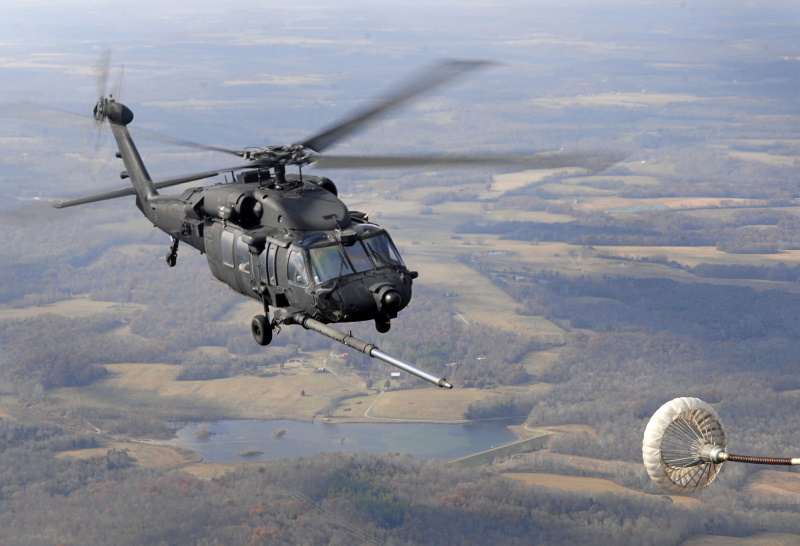
Incidentally, in principle Hellfire can be carried on a utility Black Hawk with ESSS, and some sources mention this as a possible configuration -- but without a Hellfire sighting system, a separate platform would be needed to target the missiles. It's hard to find pictures of utility Black Hawks configured with offensive stores, though of course Volcano minelaying pods would be a practical option.
The first MH-60K performed its initial flight on 10 August 1990, with the first of an initial production batch of machines performing its first flight on 26 February 1992. 22 were obtained. While the service careers of special operations machines tend to be kept quiet, MH-60Ks undoubtedly played significant roles in the Afghan intervention and the invasion of Iraq. They were replaced by the MH-60M, see below.
BACK_TO_TOP* In February 1981, the US Army performed the first flight of a UH-60A modified as the "YEH-60B Stand Off Target Acquisition System (SOTAS)" for battlefield surveillance. This machine featured extended main landing gear that straddled a long rectangular box antenna for the Motorola SOTAS radar system. In operation, the landing skids retracted upward, allowing the antenna to rotate and scan the battlefield area. The Army decided to collaborate with the US Air Force on the much more capable E-8 Joint Stars battlefield surveillance system, based on the Boeing 707 airliner, and so the SOTAS program was canceled in September 1981.
* Less ambitiously, the Army converted a number of UH-60As to the "EH-60A" configuration, which was fitted with the "Quick Fix IIB" electronic warfare system to locate, monitor, and jam adversary communications. (This variant is confusingly referred to as "EH-60C" in many sources, since the Army reserved that designation for it, but decided not to use it.) Originally, the Army had tried to fit the Quick Fix system to the Bell UH-1H Huey, but it was simply too much for the old UH-1H to carry.
A "YEH-60A" prototype performed its first flight on 24 September 1981. Tracor Systems performed 66 EH-60A conversions up to 1988. The Army originally planned to obtain 130 EH-60As, but ran out of money. The EH-60A could be recognized by the two large dipole antennas along each side of the tailboom, and a long whip antenna that could be pivoted down from the belly in flight. The EH-60A carried two operators along with pilot and copilot, and featured a datalink system to download intelligence data to ground stations or other platforms.
In the late 1990s, about seven EH-60As were upgraded to "EH-60L Advanced Quick Fix" configuration, with the airframes brought up to UH-60L specification (with the more powerful engines and more rugged transmission) and improvements in avionics. However, there were no more conversions, and in fact it is unclear that the EH-60Ls were ever fielded. In any case, the EH-60As were retired in 2005, being returned to the utility role.
* Nine UH-60As were modified as VIP transports and supplied in 1998 to the US Marine Corps' HMX-1 based out of Quantico, Virginia. These machines featured:
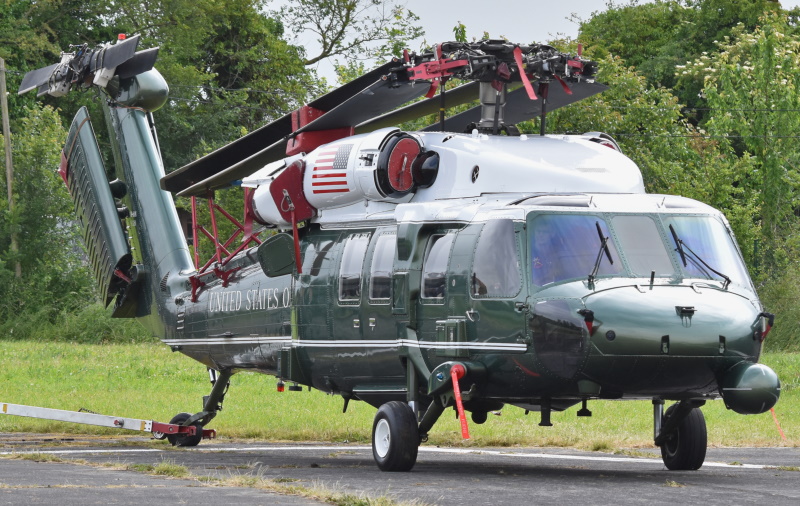
They were originally given the designation of "VH-60A", which was changed to "VH-60N" in 1989. The VH-60Ns are used to support the US President and his staff, and are known as "Presidential Hawks" or more informally "White Hawks". Their callsign is "Marine One" when carrying the chief executive. They are painted in shiny white and dark forest green colors. It appears these are the only Black Hawks in formal USMC service.
BACK_TO_TOP* The US Air Force is also an S-70 user, employing the type for the combat search and rescue (CSAR) and special operations roles. The path the USAF took to get that capability is a long story.
In the early 1980s, the Air Force wanted to find a replacement for the Sikorsky S-61R / HH-3E "Jolly Green Giant" and Bell HH-1 Hueys then in service in the USAF SAR role. The S-70 looked like the right tool for the job, resulting in a series of programs that had an odd tendency to go down dead ends:
* A number of other UH-60As and UH-60Ls may have been brought up to something resembling the Credible Hawk configuration, but if so it was strictly as a temporary measure, since the Credible Hawks were to be brought up to "MH-60G Pave Hawk" configuration in a multiphase program. Initial updates featured:
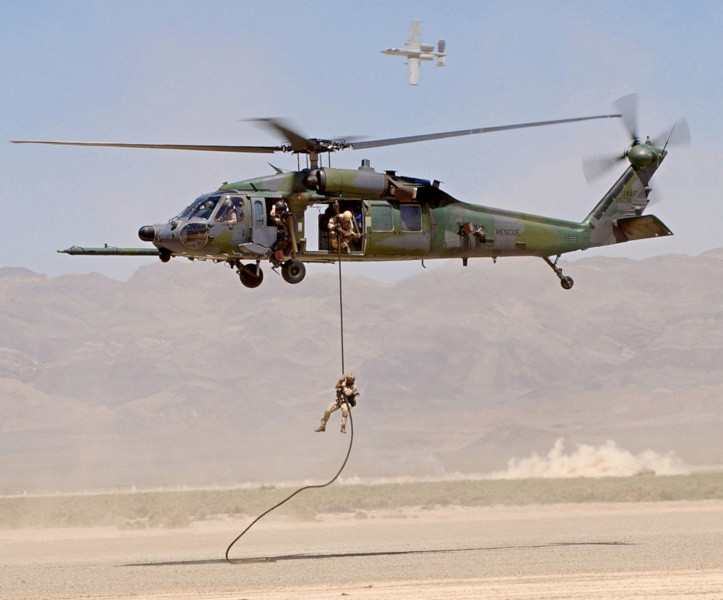
Follow-on updates included:
Confusingly, not all the machines were given full upgrades, with only 16 of the 98 MH-60Gs initially being brought up to the extended spec and used for special operations, with the rest being redesignated "HH-60G" in 1991 and used for the CSAR role.
By the end of the 1990s, all the MH-60Gs had acquired the HH-60G designation, though it is not clear if they were all brought up to a common spec. To make matters more confusing, it appears that follow-on upgrade programs were performed, and there were further conversions. By 2016, the Air Force had 97 HH-60Gs, which was short of the 112 needed. There had been a number of losses, the HH-60Gs having been heavily tasked in operational zones. Plans were established to perform more conversions to bring the fleet up to strength, with all the machines brought up to a modernized avionics fit.
The Air Force has also acquired four "UH-60U" machines by conversion, these rotorcraft being similar to the HH-60G, but without mid-air refueling capability. It appears they are used for training exercises; in any case, they are not used in operational theaters.
* The Air Force decided to replace the Pave Hawk with a "Combat Rescue Helicopter (CRH)", designated the "HH-60W" Black Hawk, similar to the HH-60G but with refinements, most notably fuel supply almost doubled. A contract was awarded to Sikorsky for a preliminary batch in 2014. There were no other bidders on the contract, the spec being so tightly written as to make it evident what the Air Force's expectations were.
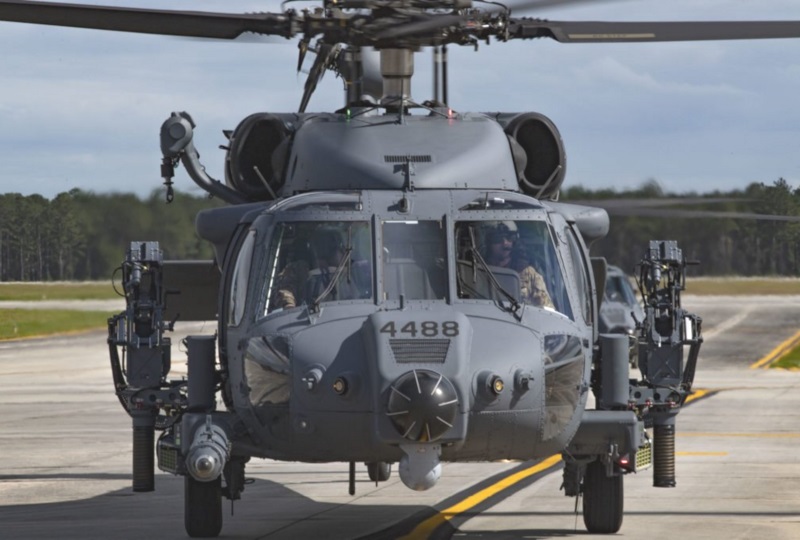
The first of four prototype machines flew in the spring of 2019, with the four prototypes followed by five service-test machines. 112 HH-60Ws are to be obtained, with introduction to service in 2022 -- the variant being given the unimaginative name of "Jolly Green Giant II", after the Sikorsky S-61R / HH-3E, of Vietnam War fame. Ironically, even before introduction to service, the Air Force was casting about for a comprehensive upgrade program, awarding a contract to Sikorsky to that end in 2021.
BACK_TO_TOP* In the late 1990s, the Army initiated a program with Sikorsky to update about 1,500 existing Black Hawks to the new "UH-60M" standard, renewing the machines for decades more service. Initial flight of the first of four UH-60M prototypes was in 2003. The four prototypes represented different production paths:
The UH-60M upgrade featured:
A low-rate production contract was issued in the summer of 2005, with service deliveries of UH-60Ms from 2008. Northrop Grumman is upgrading old UH-60L machines to a similar cockpit standard as the UH-60M, along with the T700-GE-710D engines and the beefed-up gearbox, but not the other UH-60M features. These upgraded machines are designated "UH-60V". Initial flight of the first of three prototypes was in 2017, and first redelivery of a UH-60V in late 2020. The UH-60As are to be retired by 2024 -- possibly being given updated engines and minor avionics updates, to be passed on to US allies.
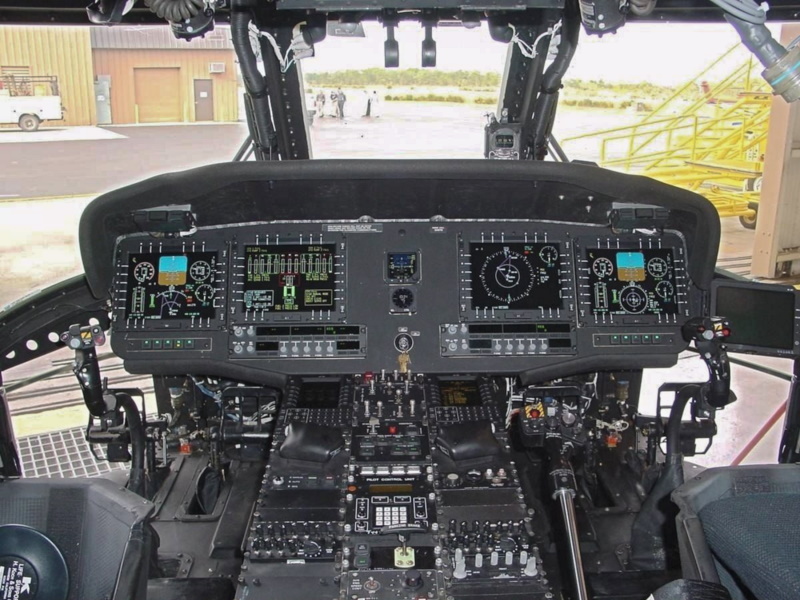
The US Army's goals in the UH-60M program expanded, with a target of 956 UH-60Ms and 419 HH-60Ms, for a total of 1,375 new rotorcraft, plus 760 UH-60V upgrades. There's supposed to be 72 MH-60M special operations machines in the mix as well; it appears they're counted as part of the UH-60M total. US Customs has obtained four UH-60Ms as well.
* In 2003, the Army took delivery of the first "Army Airborne Command & Control System (A2C2S)" or "EUH-60L", a flying command post based on the UH-60L. The EUH-60L was fitted with five tactical workstations and communications to support commanders at the battalion level and higher. The system was able to obtain intelligence information over datalinks from unmanned aircraft and other platforms, assimilate it, and pass commands to tactical elements in action.
The EUH-60L was not intended to operate as a "flying command post" as such; the helicopter platform was simply intended to fly from one location to another, with command post operations conducted on the ground. The Army plans to obtain a total of 121 A2C2S machines. Formal operational introduction was in 2004. Production has transitioned to the "Block 2" spec, based on the UH-60M with systems improvements and designated "EUH-60M".
* Since 2006, Sikorsky has promoted an "S-70i International Black Hawk" variant, essentially a UH-60M with some changes in mission equipment, with some of the kit specified by users, and modifications intended to ease multinational collaborations in production and assembly. PZL Mielec in Poland -- which had been bought out by Sikorsky in 2007 -- was the first producer, with the initial PZL S-70i rolled out in March 2010, the assemblies being provided by a global supply chain. Full production of the S-70i began in 2012. PZL Mielec then went on to produce a civilianized "S-70M", introduced in 2021.
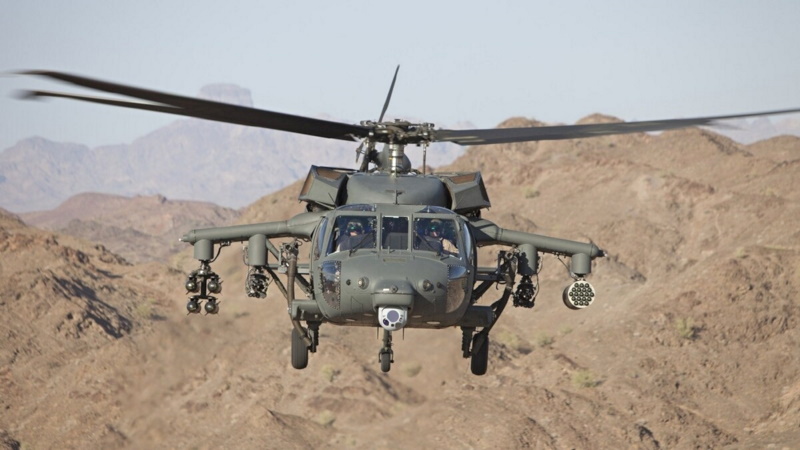
Along with the S-70i, Sikorsky introduced a "Battlehawk" armament system for the UH-60M and S-70i, with an undernose optics / targeting turret, machine gun armament, and stores pylons for Hellfire missiles, 70-millimeter guided rockets, or cannon pods. None of the stores were really anything new to the Black Hawk -- but the armed S-70 featured weapons system control integrated into the cockpit avionics, instead of merely being tacked on.
* The Army discussed a "Future Utility Rotorcraft (FUR)" -- previously the "UH-60X", derived from the UH-60 -- with Sikorsky, but the service's interest moved on to the "Joint Multi-Role (JMR)" program, which evolved in turn to the "Future Vertical Lift (FVL)". The FVL is developing demonstrators of next-generation rotorcraft that will be the basis for replacing, in part or in whole, the current fleet of US military helicopters.
For the shorter term, the Army initiated an "Improved Turbine Engine Program (ITEP)", to develop a new turboshaft in the class of 2,240 kW (3,000 SHP) to re-engine Army Apaches and S-70s. ITEP directly followed the "Advanced Affordable Turbine Engine (AATE)" demonstration program, run from 2008 to 2014, which specified an engine in the ITE power class that could fit into rotorcraft built for the T700.
Specifications for the ITE included 50% more power, 25% better fuel efficiency, and a 20% longer lifetime. Goals were to increase range by over 50%, and more than double maximum payload, with the engine being more reliable and easier to maintain. The competition in the ITEP contest was between General Electric and the Advanced Turbine Engine Company (ATEC) -- a collaboration of Honeywell with Pratt & Whitney. GE won the competition in 2019 with the company's T901-GE-900 turboshaft. From 2022, Sikorsky is refitting UH-60Ms with the T901; new-build S-70s of course have the new engine as well.
* As a footnote to the story of Black Hawk variants, in 2011 the US Special Operations Command (SOCOM) performed a raid on a compound in Pakistan to kill master terrorist Osama bin Laden. One of the footnotes to the raid was the loss of a Black Hawk that had been specially modified, with "stealth" features -- most notably a "duckbill" nose, plus masked engine intakes and exhaust, as well as an altered rotor hub. No details have been released of the "stealth" Black Hawk to date.
BACK_TO_TOP* The Blackhawk ended up being a relatively expensive helicopter in its capability class because it was designed for survival under fire. Since that's not really a concern for civil helicopters, the Blackhawk is unusual in civil service. However, at least 16 UH-60 machines in a fire-fighting configuration have been delivered since 2001, with the first obtained by Los Angeles in 2001.
These "Firehawks" had extended landing gear and a belly water tank, with a capacity of 3,790 liters (1,000 US gallon); they also have a 110-liter (30 US gallon) tank for foam and retardant. The water tank could be loaded while landed; or while hovering over a body of water, drawing in water using a retractable snorkel. They also had nose radar. When not fighting fires, they could be used for SAR and as air ambulances.
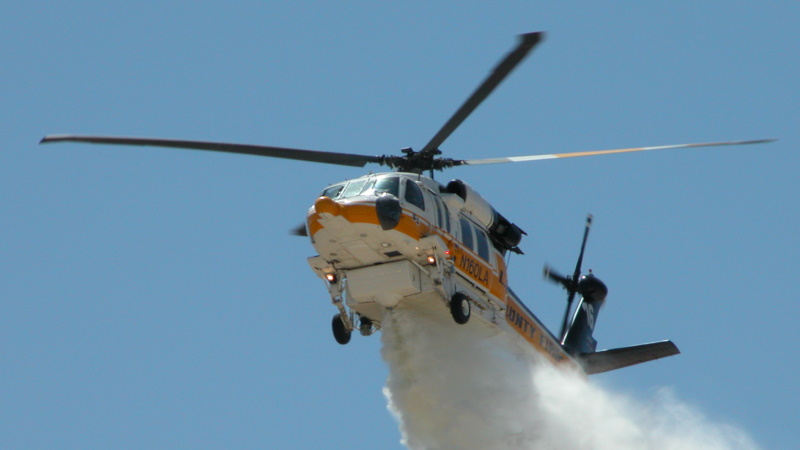
To no surprise, the Black Hawk has been extensively exported, with four user nations building it under license: Australia, Japan, South Korea, and Turkey. Poland doesn't count in that regard, since Sikorsky owns PZL Mielec.
Australia obtained a single "S-70A-9" Black Hawk from Sikorsky in 1988, leading to production of 38 more locally by Hawker de Havilland. These machines were originally assigned to the Royal Australian Air Force, but later reassigned to the Australian Army. They were basically UH-60Ls with HIRSS exhausts, cable cutters, the Seahawk AFCS and folding stabilator, an external rescue hoist, and some Australian-specified avionics. Sikorsky offered the Australian Army an armed reconnaissance variant named the "Battlehawk", but the Aussies didn't buy it.
The Australian Army retired its S-70A-9 machines, the type going out of service in 2019, being replaced by the NH Industries NH90. A number of these retired Black Hawks went into Australian government service, with at least two put into the fire-fighting role. The NH90 was not satisfactory, being judged an unreliable "hangar queen", so in 2023 Australia ordered 40 UH-60Ms to replace them in turn. They won't be built locally.
Mitsubishi in Japan license-built the UH-60L in a SAR version designated the "UH-60J" to replace the Kawasaki-Vertol KV-107 Sea Knight in Japanese service. The UH-60J variant featured external fuel tanks on upswept ESSS mounts; an external rescue winch; Japanese-built radar and a FLIR turret in the nose; plus bubble side windows for observers.
Sikorsky delivered the first pattern example, which had the company designation of "S-70A-12", with two more supplied as kits for assembly by Mitsubishi. All following production was built by Mitsubishi, with the T700 engines license-built in Japan by Ishikawajima-Harima. The first Mitsubishi-built machine was delivered in early 1991, the type becoming operational in 1992.
40 UH-60J machines were obtained by the Japanese Air Self-Defense Force (JASDF). JASDF UH-60J machines were fitted with T700-IHI-701A engines and have four litters; they were painted in high-visibility yellow-and-white colors, or in disruptive camouflage colors. From 2010, Mitsubishi began production of 40 new "UH-60J+" machines to gradually replace the old JASDF US-60Js. The UH-60J+ had modernized avionics and a midair refueling probe; it appears that some old UH-60J machines were fitted with the refueling probe, and possibly some avionics updates, as well.
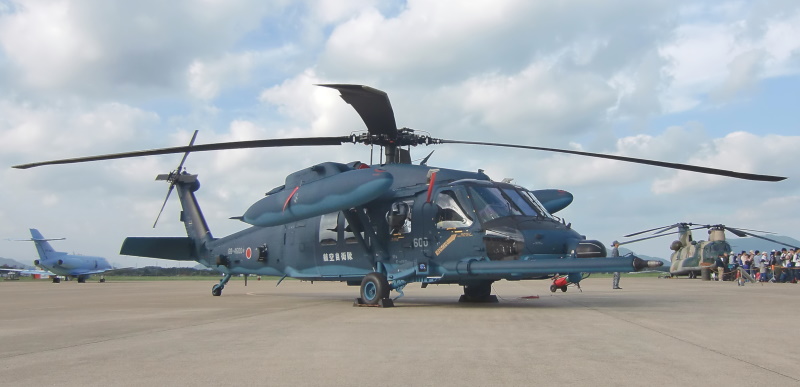
19 more UH-60J machines were obtained by the Japanese Maritime Self-Defense Force (JMSDF). JMSDF UH-60J machines were fitted with marinized T700-IHI-401C engines and had 11 litters. 11 litters sounds a bit crowded, but 11 is the number of crew in a JMSDF P-3C Orion patrol aircraft, and the JMSDF UH-60Js were configured accordingly. JMSDF SH-60Js were painted in bright red-and-white colors.
In 1995, the Japanese Ground Self-Defense Force (JGSDF) ordered a utility variant of the UH-60L from Mitsubishi, designated the "UH-60JA". It featured a UH-60L airframe but improved avionics, including FLIR, color weather radar, GPS navigation receiver, and an NVG-compatible cockpit. The first evaluation machine was delivered in 1997, with several dozen delivered so far.
The biggest foreign user of the Black Hawk is actually South Korea, with 138 "UH-60Ps" in service, very similar to the UH-60L. The first was delivered from Sikorsky in late 1990, with the next 19 assembled by Korean Air from knockdown kits, and the rest built in Korea. A number were converted by Elbit Systems of Israel to an "HH-60P" CSAR spec. South Korea also obtained three "S-70A-22" AKA "VH-60P" VIP transports, built by Sikorsky.
Turkey obtained 12 "S-70A-17s" for police and paramilitary police forces, including two VIP machines, followed by orders for 140 from the 1990s for "S-70A-28" machines. Late deliveries featured a "glass cockpit" and over machines were upgraded to the same spec. Apparently one was hit by a rocket-propelled grenade (RPG) during squabbles with Kurdish insurgents, with the Black Hawk making it back home with a gaping hole in the tailboom. The Turks called the type the "Yarasa (Bat)".
In 2014, Turkey signed a deal with Sikorsky to license-produce the S-70. Turkish Aerospace Industries to build the "T70" variant, with cockpit optimizations as per Turkish requirements. The first example, a PZL Mielec S-70i, was delivered in 2019, with a new digital cockpit integrated by Sikorsky and Aselsan of Turkey. Initial production is to run to 109 machines, with a possibility of 600 or more over the longer run. Given rocky relations between Turkey and the USA, it is not clear what the status of this effort is.
* There is a long list of other Black Hawk users. Afghanistan obtained the first of at least 150 hand-me-down US Army UH-60As in 2017. They were intended to replace the Afghan fleet of Mil Mi-17s, which were overtasked and wearing out. They were upgraded to "UH-60A+" configuration, with uprated T700-GE-701D engines. About half the Afghan Black Hawks were in a utility configuration, the other half in an armed configuration. n. They were generally abandoned when the Taliban took over Afghanistan in 2021, though there are rumors some escaped to neighboring countries.
Colombia is a big user of the Black Hawk, though the delivery history is confusing and hard to sort out. The Colombian National Police obtained 6 UH-60L Blackhawks in 1998, followed by two more in 2000. The Colombian military obtained 10 UH-60As in 1988:1989, with most of these upgraded to UH-60L spec later; then obtained 22 UH-60Ls more in the 1990s; followed by 14 in 2000 and 15 in 2005, for use in the "drug war" against Colombian FARC insurgents. That gives a total military force of 61. At least some were delivered under the designation of "S-70A-41".
The Colombians came up with a sophisticated gunship variant, the "AH-60L Arpia (Harpy Eagle)". Originally, it was fitted with the ESSS, carrying twin 12.7-millimeter (0.50-caliber) Herstal M3P machine-gun pods and two 19-round 70-millimeter rocket launchers, with NVGs used for night operations. They were later refined to an "Arpia II" configuration, with GAU-19 three-barrel 12.7-millimeter Gatling guns on the ESSS, with a Herstal gun in each door for rear protection, as well as a 7.62-millimeter M60D machine gun in a window on each side for backup.
The definitive configuration, the "Arpia III", featured an Israeli Elbit Systems Toplite II system -- with FLIR, daylight TV, plus laser designator / rangefinder -- and an Airbus-built defensive countermeasures suite. The door guns were upgraded to GAU-19 12.7-millimeter Gatlings, though sometimes GAU-17 7.62-millimeter Miniguns have been fitted instead. The Arpias occasionally carry "aerial special commandos" armed with Barrett M82 12.7-millimeter sniper rifles, who can provide very highly precise application of firepower. In response to frictions with Venezuela, Colobia updated the dozen AH-60Ls in service to "Arpia IV" configuration, with the updated "Toplite III" system; other avionics updates; and in particular carriage of the Rafael Spike anti-armor missile.
Colombia also configured three UH-60L "Angel" CSAR machines, with FLIR, radar, rescue hoist, Miniguns mounted in the doors, chaff-flare dispensers, and medical kit. An Angel sent into a "hot" area was always accompanied by an Arpia.
* Israel received ten surplus US Army Black Hawks in July 1994, free of charge. The Israeli Air Force later purchased at least 39 new-build UH-60Ls. The Israeli machines were designated "UH-60A-50"; the Israelis called the type the "Yanshuf (Owl)".
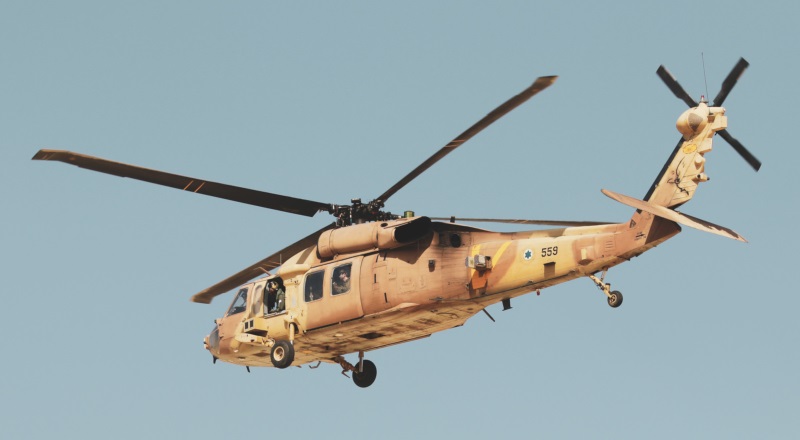
* Mexico has obtained 48 UH-60L and UH-60M Black Hawks since 1991, for the Mexican Navy, Air Force and Federal Police, their primary mission being to fight drug traffickers and crime syndicates. The Mexican State of Jalisco took delivery of one S-70i in 2011.
* The Philippines obtained 16 S-70i Black Hawks, with initial deliveries in 2020, and then ordered 32 more in 2022.
* The UAE is estimated to have almost 70 Black Hawks with Sikorsky investing in the Advanced Military Maintenence Repair and Overhaul Company (AMMROC) joint venture with Lockheed Martin and UAE state-owned Emirates Defence Industries Co. (EDIC).
In February 2011, the UAE announced a $270.5 million upgrade order from Sikorsky for 23 UH-60Ms with Battlehawk kits.
* Saudi Arabia obtained 21 "Desert Hawks", including 12 "S-70A-1" machines configured as utility transports, one S-70A-1 configured as a VIP transport, and 8 "S-70A-1L" medevac machines. The utility transports could be fitted with French GIAT 20-millimeter cannon on pintle mounts, while the medevac machines had an external hoist, provision for six litters, and a searchlight. The Saudi National Guard ordered 24 S-70Ls in 2006, with all surviving S-70As in Saudi service updated to S-70L spec from 2010. The Saudis ordered 17 UH-60Ms in 2017 -- these machines apparently piecing into a much larger deal whose details are unclear.
* Taiwan ordered 60 UH-60Ms in 2012, with deliveries completed in 2020. They were apportioned to the Army, Air Force, and National Airborne Service Corps (NASC) -- a consolidation of civil government air assets, created in 2004 from the air assets of the National Police, National Fire Agency, Civil Aeronautics Authority, and Coast Guard. It appears these machines were fitted out to a range of configurations, including medevac, fire-fighting, and possibly special operations / CSAR.
* Although details are unclear, the United Arab Emirates (UAE) are believed to have almost 70 Black Hawks in service, with many fitted with Battlehawk combat kits. Other nations that obtained the Black Hawk in small or moderate quantities have included:
Britain is not a formal user of the Black Hawk, but one "S-70A-16" was supplied to Rolls-Royce for testing Rolls / Turbomeca TRM-332 turboshaft engines, and some sources claim a single "S-70A-19" was supplied to Westland preparatory to a license production deal that fell through. The Westland-built Black Hawks were to be assigned the "WS-70" designation.
Sikorsky has sold an "S-70C" version of the Black Hawk that is supposed to be for civil operators, but that description partly appears to be a "cover" for selling Black Hawks to nations where selling something clearly identified as a "weapon" was troublesome. One of the prominent buyers of this variant was China, with 24 obtained in the 1980s. They were among the most capable rotorcraft in China's inventory, and some were assigned to high-altitude regions where their greater power came in handy.
It appears that obtaining spares became difficult for a while after the 1989 Tiannemen Square massacre. That may have been one of the motivations for China to develop their own take on the Black Hawk, the Harbin-Changhe "Z-20", which performed its first flight in 2013. Such photos as have been released show it looks so much like a Black Hawk that it's been nicknamed the "Copyhawk" -- though it does differ in details, for example having a five-bladed rotor. It entered service in 2018, to become the China People's Liberation Army's standard medium utility helicopter. There are indications a "stealth" version of the Z-20 has been developed.
BACK_TO_TOP